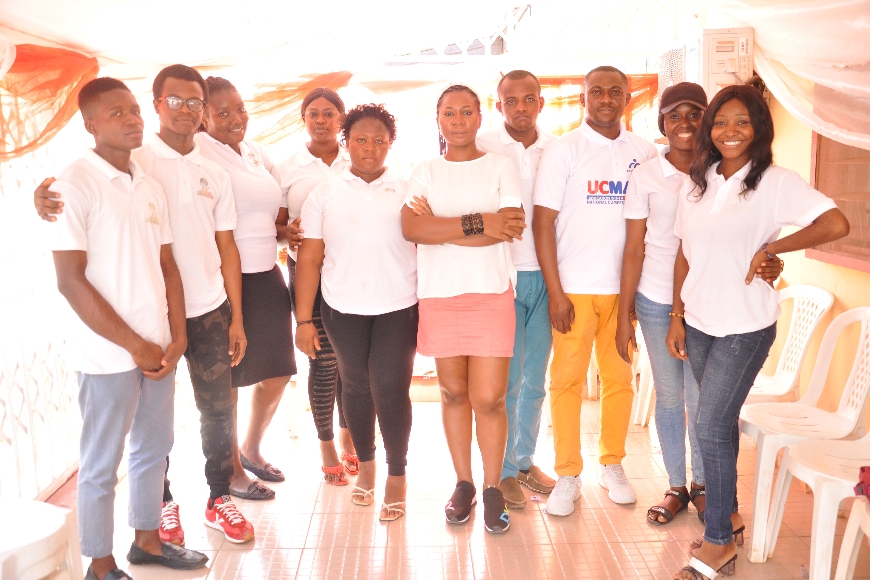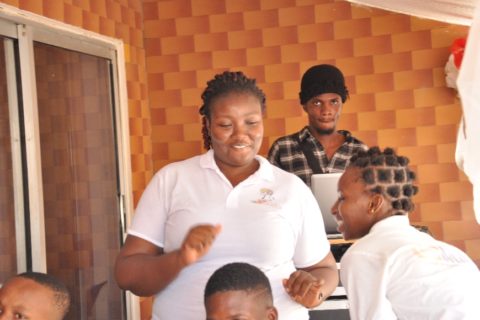
According to scientific research, a child who lacks quality mental formation can experience a sharp decline in mental abilities as early as the age of 20. On the other hand, a child who receives this information by the age of 12 will continue to remain brilliant even up to the age of 70. Many researchers in Asia have claimed and proven that abacus stimulates whole-brain development. When children use their index and thumb to move the abacus beads to perform arithmetic calculations, there is a quick communication between the finger movements and the brain. After the eyes have been exposed long enough to seeing the abacus, and fingers have sufficient practice at moving the beads, the abacus can then be removed, and a mental picture replaces the physical abacus. This promotes rapid, balanced, whole brain development, and fast mental math skills. Reading, listening, and flash cards is used to achieve this mental prowess.
1. Reading: When doing equations, children read the beads on the abacus. During this process, the eyes send a visual to the brain, placing a picture of the Soroban in their mind. The right hemisphere later uses this picture to create a mental image of the abacus. The right hemisphere, which is the faster processor, then allows children to do incredibly fast mental calculations.
2. Listening: Just as the auditory pathway is developed at a young age to enable fluency in a language, the auditory pathway can be developed for numbers as well. The average adult has difficulty calculating without pen and paper because reading numbers have dominated their math journey. Listening to the numbers trains the brain much like reading does, except it uses a different pathway. Amplifying the auditory pathway for numbers develops brainpower and skills that take students to the next level.
3. Flash cards: When we enter a room, we instantly take in information from our surroundings. This is something we do without even trying. The more fine-tuned our attention to detail is, the more aware we are and the quicker our recall. When children do flash cards, they are absorbing the numbers visually. Because their ability to visualize and use their mental abacus is already sharp by this point in the training, they can read the numbers being flashed, compute, and answer the calculations almost instantly. The more trained this pathway is, the more rapid their mental maths skills are.
1. Abacus training is unique
For its ability to develop both brain hemispheres by using an imaginary abacus for mathematical computation. The Soroban claims exclusive rights in enabling all children to achieve speeds in math previously linked only to mathematical geniuses, while simultaneously developing both hemispheres.
2. In addition to strong mental skills,
It strengthens the brain by activating the power of both hemispheres. This enables children to use their left hemisphere (logic, sequential, rational, scientific, and reading) to manipulate beads on an imaginary abacus created by the right hemisphere (creative, intuitive, writing, art, music).
3. Developing the Left and Right Hemispheres
Is then amplified by using multiple pathways such as spoken numbers and flash cards. This results in a stronger brain muscle, making it easier to learn any subject regardless of which hemisphere is responsible for its function. Examples: reading, music, science, etc.
BENEFITS OF UCMAS
• Enhances FASTER mental math skills. Improves understanding of arithmetic.
• Increases MEMORY, FOCUS, listening skills, imagination, and creativity.
• WHOLE -BRAIN training. Develops left and right hemispheres.
• FUN and EASY! Ignites a LOVE for MATH and builds a solid foundation.
• Develops CONFIDENCE and SELF- ESTEEM.
• Increases ENDURANCE and academic stamina. Develops discipline and character.
Are geniuses born or made?/Ignite the genius in your child
Every child is a genius. That doesn’t mean that every child can score 150 on an IQ test. But every child is a genius according to the original meanings of the word “Genius” which origin is in Greek, meaning “to give birth” (related to the word genesis) and “to be zestful or joyful” (related to the word genial). Essentially the real meaning of genius is to “give birth to the joy” that is within each child. Today a Genius is defined as “An exceptionally intelligent person or one with exceptional skill in a particular area of activity”.
We all have expectations for our children to do their greatest but how do we foster a love affair with knowledge and nurture their developing minds? An infant has twice as many brain connections as an adult and as parent we have to help them connect as many brain neurons as possible as brain neuron connections stops at the age of 18. The young child masters a complex symbol system (their own native language) without any formal instructions. Experts say there is a little genius in almost everyone. It is part genetics but also what parents do early on to bring it out of them. All children are capable of anything, depending on how it is presented to them and the effort which they put into learning it. So yes geniuses are not only born they are made.
Math is one of the most basic skills we expect our children to master. Reading, writing and arithmetic: these are the three subjects often named as being of paramount importance. And yet, while much focus is put on early literacy skills including reading and writing, math is often lost in the shuffle. But teaching your child math skills from an early age is more important than you might think.
Mastery of early math skills predicts not only future math achievement; it also predicts future reading achievement, recent studies shows. Research into the importance of early math skills shows that children who are taught math early and learn the basics at a young age are set up for a lifetime of achievement in all aspects of their academic performance. Building more advanced math skills is just one of the areas in which basic math taught early on can make a difference.
While we all want our kids to achieve greatness in life, it’s important to acknowledge that early childhood is the most crucial growing period of a human life in terms of emotional, intellectual, physical and social development. While it’s a scientific fact that human brain growth is at its peak potential in early childhood, it’s also a fact that all children process information differently. No child is the same, and while some children learn better through reading, others learn better through doing – which brings us to the topic of mathematics!
Let’s be honest, kids don’t like mathematics. This is not an issue isolated to just Nigerian Kids. In fact, according to research, most adults loathe it too. Interestingly, many adults feel that if they could have been exposed to a smarter way of learning mathematics as a child, then their outlook would be a far more pleasant one. For most kids, mathematics is extremely difficult and boring, and unless an interest is taken in learning it from a young age, they will always have a love-hate relationship with it. So how do we get our kids interested in learning mathematics and also help them connect more brain neurons? One of the best and most successful proven ways in which to make the subject of mathematics more attractive and interesting is with UCMAS.
UCMAS whole brain development program builds foundational techniques that make learning math effortless and enjoyable. By mastering UCMAS techniques using the Abacus students develop the ability to think in pictures and quickly learn to perform large calculations mentally. Over time UCMAS students come to love a subject they may have once struggled with or even feared.
UC ACTIVITIES – LEARNING STYLES & SKILL DEVELOPMENT TECHNIQUES
Activities in a UCMAS class help children develop their Kinaesthetic, Auditory and Visual learning styles. Children generally have a pre-dominant style of learning; but at UCMAS we enhance each learning style, which not only enhances their dominant style but also develops their less dominant style of learning
Tactile/ Kinaesthetic Learning Style: Tactile/ Kinaesthetic learners learn best when they can use their sense of touch using physical objects or body movement – The UCMAS program focuses on the physical use of abacus for representing and calculating numbers. Other activities like the types of speedwriting facilitate this type of learning.
Auditory Learning Style: Auditory learners are those who learn best through hearing. In the UCMAS program students calculate by listening to numbers in extremely high speeds. In addition listening and writing jumbled dictations also help auditory learners. Thus strengthening their auditory style of learning.
Visual Learning Style: Visual learners are those who learn and understand better through visual aid or by seeing and observing things. On going use of the physical abacus helps students visualize the beads of the abacus, hence giving them a gift of Mental Math. At UCMAS we conduct various activities with flash cards, which are bead representation of numbers. These activities help children enhance their visual leaning style.
OTHER OFFERINGS
AT our Centre we also Offer;
Coding and Robotics
Diction and Reading club
CODING & ROBOTICS
What is Coding?
Coding, sometimes called computer programming, is how we communicate with computers. Code tells a computer what actions to take. Writing code is like creating a set of instructions. By learning to write code, you can tell computers what to do or how to behave in a much faster way. You can use this skill to make websites and apps, process data, and do lots of other cool things.
Coding involves problem-solving, perseverance, collaboration, mathematical logic, and reasoning skills. You would agree that these are skills that you want for your children, right?
Like we tell our students; in the simplest way coding is giving the computer instructions. It is as simple as that, but just with humans there are different Languages used to pass instructions.
Our coding programs touch on most of the ISTE (International Society for Technology in Education) Standards for Students (ISTE, 2016). There are seven ISTE standards for students of a digital world. They are Empowered Learner, Digital Citizen, Knowledge Constructor, Innovative Designer, Global Collaborator, Computational Thinker, and Creative Communicator.
It is structured to cover fundamental concepts of computer programming and presented to students in order to reach a high level of coding proficiency, as well as acquiring the AI bases.
What is Robotics?
Robotics is an area of science, technology, and engineering that deals with creating machines (robots) that can help human beings. Since robots are physical devices, learning about robotics is a good way for kids to use their software development skills (like Scratch and Python) to program hardware.
Can coding and robotic be fun and engaging? YES!
Want to know something cool about coding and robotics?
• Do you know that it’s fun to build an application? Creating something that works and watching your idea take shape step-by-step is a blast!
• You’ll love coding if you also love building things and enjoy problem-solving. With our coding and robotic classes children get to bring their imagination to life!
• Kids as young as 8 use computer programming to solve puzzles and build games and chatbots. Kids learn coding in an engaging and rewarding environment that utilizes gaming elements.
• In our coding classes, children get reward system that spontaneously teaches them to push to be their best selves.
With our well trained instructors first timers don’t have to suffer. No previous experience? That’s not a problem! Children are given instructions and user-adapted hints and tips to help them solve challenges!
So kids pack your bags and let’s code and create Robots.
Program Structure
Here is a breakdown of our coding program and the learning categories.
Foundational Program
A: Fundamentals of computer Programming, Basic Design and Animation (Age 6 -7)
Coding concepts: Single command, sequence command, repeat loops (single and multiple command body),
Projects: Simple Animated Projects, Animation stories, Game creation
Tools: Block Type Programs
Language: JavaScript
B: Fundamentals of computer Programming, Basic Design and Animation (Age 8 and above)
Coding concepts: Single command, sequence command, repeat loops (single and multiple command body), Sequence of repeat loops, input/output, variables, if-else, if-else-if,operators.
Projects: Simple Animated Projects, Animation stories, Game creation, Apps creation.
Tools: Block Type Programs
Language: JavaScript
Program 1
A: Animation, Games and Apps
Coding concepts: Single command, sequence command, repeat loops (single and multiple command body), Sequence of repeat loops, input/output, variables.
Projects: Simple Animated Projects, Animation stories, Game creation, Apps creation
Tools: Block Type Programs
Language: JavaScript
Program 2
Basic Games and Apps Creation
Coding concepts: Single command, sequence command, repeat loops (single and multiple command body), Sequence of repeat loops, input/output, variables, if-else, if-else-if, operators, do until loop with relational operators, do until loops with logical operators.
Projects: Game creation, Advance Apps creation.
Tools: Block Type Programs
Language: JavaScript and Python
Advance Program:
The content is determined by the learning path of the classes, it involves Text Based
Programming languages ranging from: HTML, CSS, Java Script, Python, etc.
DICTION AND READING CLUB
DICTION
There’s a saying that many people talk, few people speak whilst a fraction articulate. What exactly is the difference between speaking, talking and being eloquent? Diction is the difference!
Diction simply is the manner of expressing ideas. It is the speaking/writing style or the choice of words a speaker or writer uses.
The choice of words a speaker or writer uses has a significant effect on the quality of speech or writing. Well-chosen words help a writer or speaker to pass a message clearly or easily. Speaking impeccably will greatly increase your confidence and you will feel like you can take on the world.
Speaking in the right diction is not about changing your accent or sounding foreign. It is about elocution. It is about social intelligibility; the ability to be heard and understood anywhere in the world.
Here are some of the likely reasons why children shy away from expressing themselves
– They may have been shunned countless times for using wrong tenses
– They are not sure if they can arrange their points properly
– They are afraid of being judged
– Nervousness
At our diction class children are able to:
– Express themselves properly while speaking eloquently in the right diction and with the right stress placement and inflection.
– Read and write properly while correctly doting their I’s, placing commas and full stop rightly.
– Use the right tenses while speaking
– Introduce themselves with confidence
– Be creative in writing.
Here’s an opportunity to equip your child with life skills that will stay with them for the rest of their lives. Let us help you transform that talker to a speaker and that fearful reader to a confident book worm.
BOOKCLUB
Do you want to broaden your child’s horizons, enhance his/her social skill and foster deep thinking for your child? Book club is the magic!
Book club is a reading group, usually consisting of a number of people who read and talk about books.
What goes in our book club?
• Interactions: Children interact together in many different ways, which helps your kids to develop useful socialization skills. In some cases, it can even help to overcome traits such as shyness and attitude issues and help to develop public speaking skills.
• Inspiring prompts and story creation lessons that spark imaginations: Children are able to build their imagination power and are inspired to do creative thinking. Children create their own magical animal characters to take through the magical world.
• Fun: We have engaging games that increase vocabulary and improve spelling.
Our books range from:
Novels; fantasy and history books; books on adventures, travels, galaxies and dinosaurs; poetry, rhymes and songs; newspapers and magazines.



